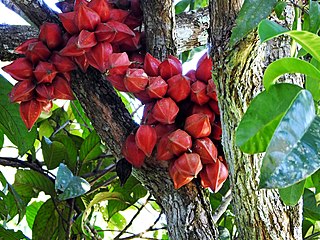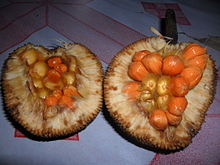
Bhesa indica is a flowering plant tree species in the Centroplacaceae family. It is distributed along the tropical wet evergreen forests of the Western Ghats of India. It is considered synonymous with Bhesa paniculata by some authors.
Durio kinabaluensis, also known as mountain durian and (locally) as durian tapuloh, is a forest tree in the mallow family.
Durio crassipes, also known as durian hutan, is a species of flowering plant in the mallow family that is endemic to Borneo.
Bouea oppositifolia, also known as plum mango, kundang, kundangan or remenia, is a species of flowering plant, a fruit tree in the mango family, that is native to Indochina and Southeast Asia.
Mangifera griffithii is a species of flowering plant, a fruit tree in the mango family, that is native to Southeast Asia.
Mangifera torquenda is a species of flowering plant, a fruit tree in the mango family, that is native to Southeast Asia.
Willughbeia angustifolia is a species of flowering plant, a woody monoecious vine in the dogbane family, that is native to Southeast Asia.
Garcinia microcarpa, also known as kandis hutan, is a species of flowering plant, a dioecious understorey fruit tree in the mangosteen family, that is native to Southeast Asia.
Prainea limpato, also known as tampang susu in Malay and more locally as kesusu or empatak, is a species of flowering plant, a fruit tree in the fig family, that is native to Southeast Asia.

Artocarpus tamaran, also known as elephant jack in English, tarap tempunan in Malay, and more locally as timbangan, tamaran, entawa or wi yang, is a species of flowering plant, a fruit tree in the fig family, that is native to Southeast Asia.
Artocarpus teysmannii, also known as cempedak air in Malay and as tilap in Indonesia, is a species of flowering plant, a fruit tree in the fig family, that is native to Southeast Asia.
Ficus uncinata, also known as earth fig in English and as ara entimau in Iban, is a species of flowering plant, a fruit tree in the fig family, that is native to Southeast Asia.
Sarcotheca diversifolia, also known as pupoi or belimbing bulat in Malay and more locally as tabarus, piang or belimbing hutan, is a species of flowering plant, a fruit tree in the wood sorrel family, that is native to Southeast Asia.

Baccaurea angulata, also known as belimbing hutan or belimbing darah in Malay and more locally as ucong or embaling, is a species of flowering plant, a fruit tree in the tampoi family, that is native to Southeast Asia.

Baccaurea tetrandra, also known as mata kunau in Malay and more locally as kunau-kunau or enkuni, is a species of flowering plant, a tropical forest fruit-tree in the tampoi family, that is native to Southeast Asia.

Glenniea philippinensis is a species of flowering plant, a tropical forest fruit-tree in the lychee family, that is native to Southeast Asia.

Lepisanthes alata, also called the Johore tree, blimbing cina, ceri or engkili, is a species of flowering plant, a tropical forest fruit-tree in the lychee family, that is native to Southeast Asia.
Lepisanthes multijuga is a species of flowering plant, a tropical forest fruit-tree in the lychee family, that is native to Southeast Asia.
Nephelium cuspidatum, also known as rambutan hutan in Malay and buah sibau in Iban, is a species of flowering plant, a tropical forest fruit-tree in the rambutan family, that is native to Southeast Asia.
Nephelium maingayi, also known as serait in Malay, mujau in Iban, and buah sungkit in Sabah and Brunei, is a species of flowering plant, a tropical forest fruit-tree in the rambutan family, that is native to Southeast Asia.







